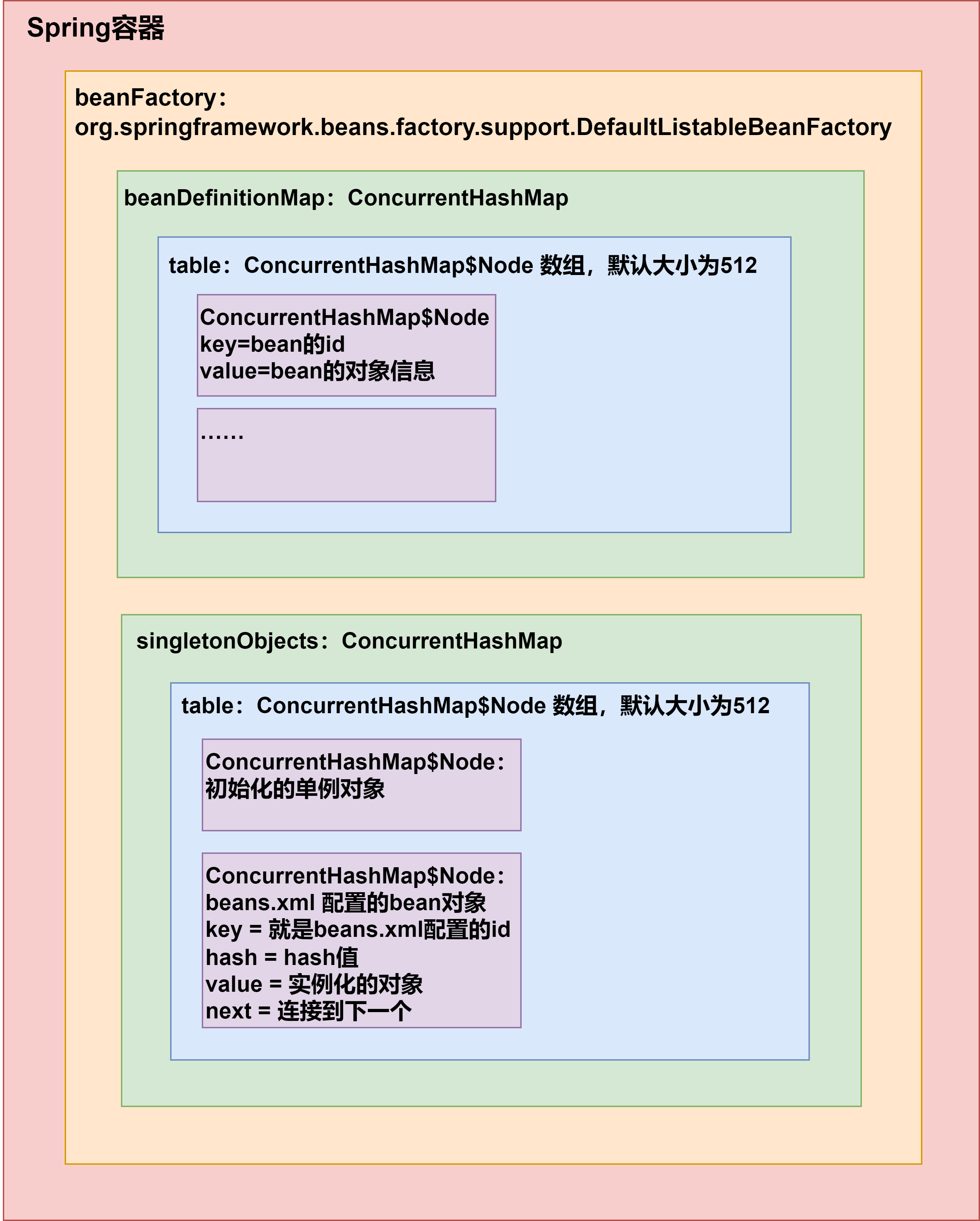Spring基本介紹02 5.簡單模擬Spring基於XML配置的程式 5.1需求說明 自己寫一個簡單的Spring容器,通過讀取beans.xml,獲取第一個Javabean:Monster的對象,給該對象屬性賦值,放入到容器中,並輸出該對象信息 也就是說,不使用spring原生框架,我們自己簡單 ...
Spring基本介紹02
5.簡單模擬Spring基於XML配置的程式
5.1需求說明
-
自己寫一個簡單的Spring容器,通過讀取beans.xml,獲取第一個Javabean:Monster的對象,給該對象屬性賦值,放入到容器中,並輸出該對象信息
-
也就是說,不使用spring原生框架,我們自己簡單模擬實現,目的是瞭解Spring容器的簡單機制
5.2思路分析

5.3代碼實現
引入dom4j.jar包

MyApplicationContext.java:
package com.li.myapplicationcontext;
import com.li.bean.Monster;
import org.dom4j.Document;
import org.dom4j.Element;
import org.dom4j.io.SAXReader;
import java.io.File;
import java.lang.reflect.Method;
import java.util.List;
import java.util.concurrent.ConcurrentHashMap;
/**
* @author 李
* @version 1.0
* 1. 這個程式用於實現Spring的一個簡單容器機制
* 2. 後面還會詳細的實現
* 3. 這裡我們主要實現的是如何將beans.xml文件進行解析,並生成對象,放入容器中
* 4. 然後提供一個getBean(id) 返回對應的對象
*/
public class MyApplicationContext {
private ConcurrentHashMap<String, Object> singletonObjects
= new ConcurrentHashMap<>();
//構造器
//接收一個容器的配置文件,如 beans.xml,預設路徑在src下
public MyApplicationContext(String iocBeanXMLFile) throws Exception {
//1.得到配置文件的類載入路徑
String path = this.getClass().getResource("/").getPath();
//2.創建 saxReader
SAXReader saxReader = new SAXReader();
//3.得到document對象
Document document = saxReader.read(new File(path + iocBeanXMLFile));
//4.得到rootDocument
Element rootElement = document.getRootElement();
//5.得到第一個bean-monster01
Element bean = (Element) rootElement.elements("bean").get(0);
//6.獲取到第一個bean的相關屬性(真實的情況下會把屬性保存到beanDefinitionMap中)
String id = bean.attributeValue("id");//bean的id
String classFullPath = bean.attributeValue("class");//類的全路徑
List<Element> property = bean.elements("property");
//原本是遍歷,這裡為了簡化,就直接獲取
//property的value值
Integer monsterId =
Integer.parseInt(property.get(0).attributeValue("value"));
String name = property.get(1).attributeValue("value");
String skill = property.get(2).attributeValue("value");
//7.反射創建對象
Class<?> aClass = Class.forName(classFullPath);
//這裡的 o對象就是Monster對象
Monster o = (Monster) aClass.newInstance();
//給對象賦值-這裡為了簡化,直接賦值(真實情況下會使用反射)
o.setMonsterId(monsterId);
o.setName(name);
o.setSkill(skill);
//8.將創建好的對象放到singletonObjects單例對象池中
singletonObjects.put(id, o);
}
public Object getBean(String id) {
return singletonObjects.get(id);
}
}
Test.java用於測試:
package com.li.myapplicationcontext;
import com.li.bean.Monster;
/**
* @author 李
* @version 1.0
*/
public class Test {
public static void main(String[] args) throws Exception {
MyApplicationContext ioc = new MyApplicationContext("beans.xml");
Monster monster01 = (Monster) ioc.getBean("monster01");
System.out.println("monster01=" + monster01);
System.out.println("monsterId=" + monster01.getMonsterId() +
" name=" + monster01.getName() +
" skill=" + monster01.getSkill());
}
}

6.Spring原生容器底層結構梳理
我們之前在Spring基本介紹01--4.5Spring容器的結構/機制有一些基礎的分析,現在來梳理一下:

7.練習
7.1關於bean的id
如下,在beans.xml中,我們註入2個Monster對象,但是不指定bean的id
<bean class="com.li.bean.Monster">
<property name="monsterId" value="100"/>
<property name="name" value="牛魔王"/>
<property name="skill" value="芭蕉扇"/>
</bean>
<bean class="com.li.bean.Monster">
<property name="monsterId" value="200"/>
<property name="name" value="紅孩兒"/>
<property name="skill" value="三昧真火"/>
</bean>
問題1:運行會不會報錯?
答:不會報錯,可以正常運行。
問題2:如果不報錯,你是否能找到分配的id並獲取該對象?
答:系統會預設分配id,分配id的規則是:全類名#0,全類名#1......全類名#n,這樣的規則來分配id
我們可以通過debug的方式來查看:
beanFactory.beanDefinitionMap.table:

package com.li.homework;
import com.li.bean.Monster;
import org.springframework.context.ApplicationContext;
import org.springframework.context.support.ClassPathXmlApplicationContext;
import org.testng.annotations.Test;
/**
* @author 李
* @version 1.0
*/
public class Homework01 {
@Test
public void getMonster() {
ApplicationContext ioc =
new ClassPathXmlApplicationContext("beans.xml");
Monster monster01 = ioc.getBean("com.li.bean.Monster#0", Monster.class);
System.out.println("monster01=" + monster01);
System.out.println("monsterId=" + monster01.getMonsterId());
Monster monster02 = ioc.getBean("com.li.bean.Monster#1", Monster.class);
System.out.println("monster02=" + monster02);
System.out.println("monsterId=" + monster02.getMonsterId());
System.out.println("ok~~");
}
}

在實際開發中不會省略bean的id
7.2練習2
創建一個Car類(屬性:id,name,price),具體要求如下:
- 創建ioc容器文件(即配置文件),並配置一個Car對象(bean)
- 通過java程式到ioc容器獲取該bean對象,並輸出
Car:
package com.li.bean;
/**
* @author 李
* @version 1.0
*/
public class Car {
private Integer id;
private String name;
private Double price;
public Car() {
}
public Car(Integer id, String name, Double price) {
this.id = id;
this.name = name;
this.price = price;
}
public Integer getId() {
return id;
}
public void setId(Integer id) {
this.id = id;
}
public String getName() {
return name;
}
public void setName(String name) {
this.name = name;
}
public Double getPrice() {
return price;
}
public void setPrice(Double price) {
this.price = price;
}
@Override
public String toString() {
return "Car{" +
"id=" + id +
", name='" + name + '\'' +
", price=" + price +
'}';
}
}
beans2.xml:
<?xml version="1.0" encoding="UTF-8"?>
<beans xmlns="http://www.springframework.org/schema/beans"
xmlns:xsi="http://www.w3.org/2001/XMLSchema-instance"
xsi:schemaLocation="http://www.springframework.org/schema/beans http://www.springframework.org/schema/beans/spring-beans.xsd">
<bean class="com.li.bean.Car" id="car01">
<property name="id" value="10001"/>
<property name="name" value="寶馬"/>
<property name="price" value="1230000"/>
</bean>
</beans>
Homework02:
package com.li.homework;
import com.li.bean.Car;
import org.springframework.context.ApplicationContext;
import org.springframework.context.support.ClassPathXmlApplicationContext;
import org.testng.annotations.Test;
/**
* @author 李
* @version 1.0
*/
public class Homework02 {
@Test
public void getCart() {
ApplicationContext ioc =
new ClassPathXmlApplicationContext("beans2.xml");
Car car = ioc.getBean("car01", Car.class);
System.out.println(car);
}
}



